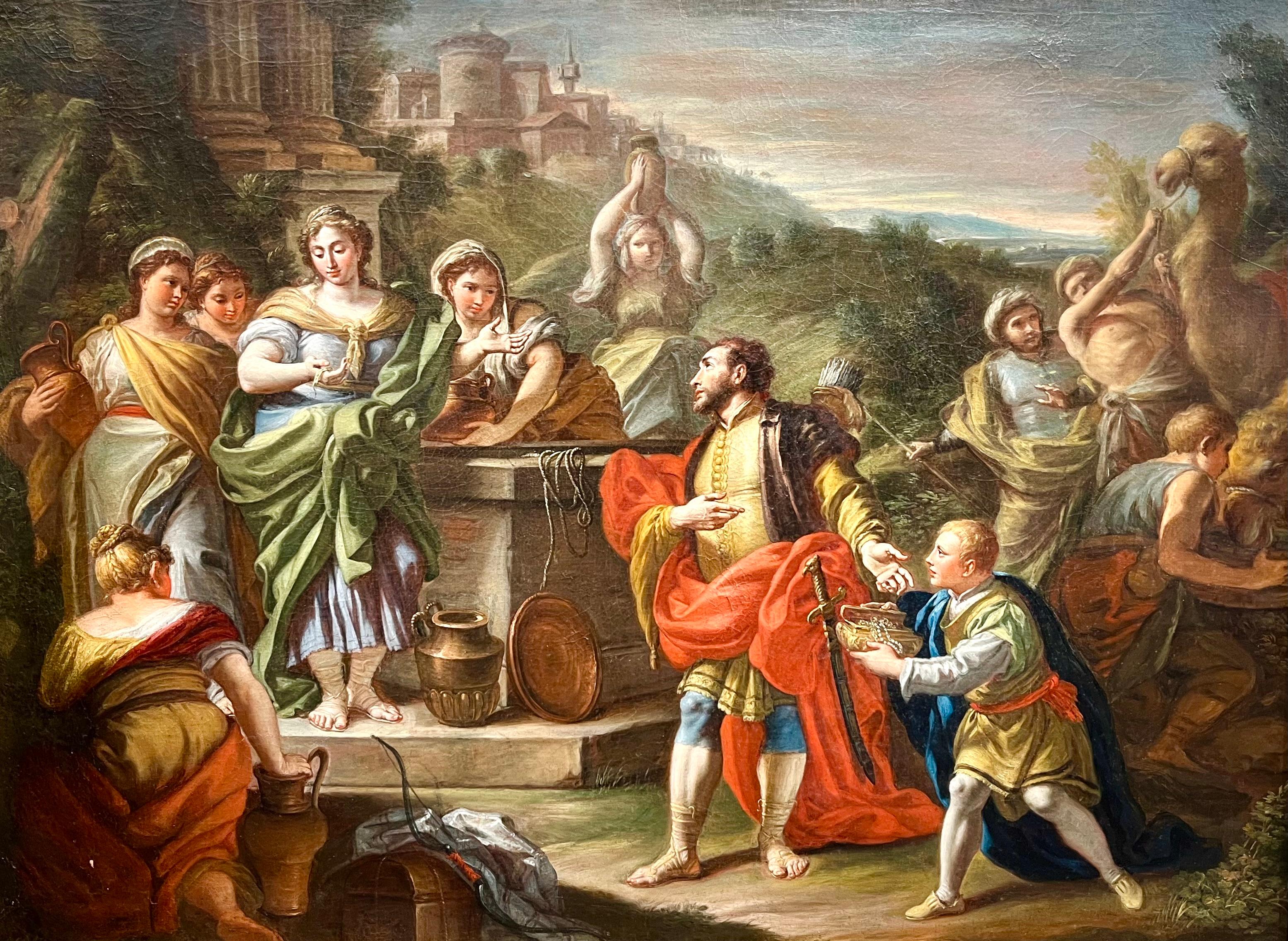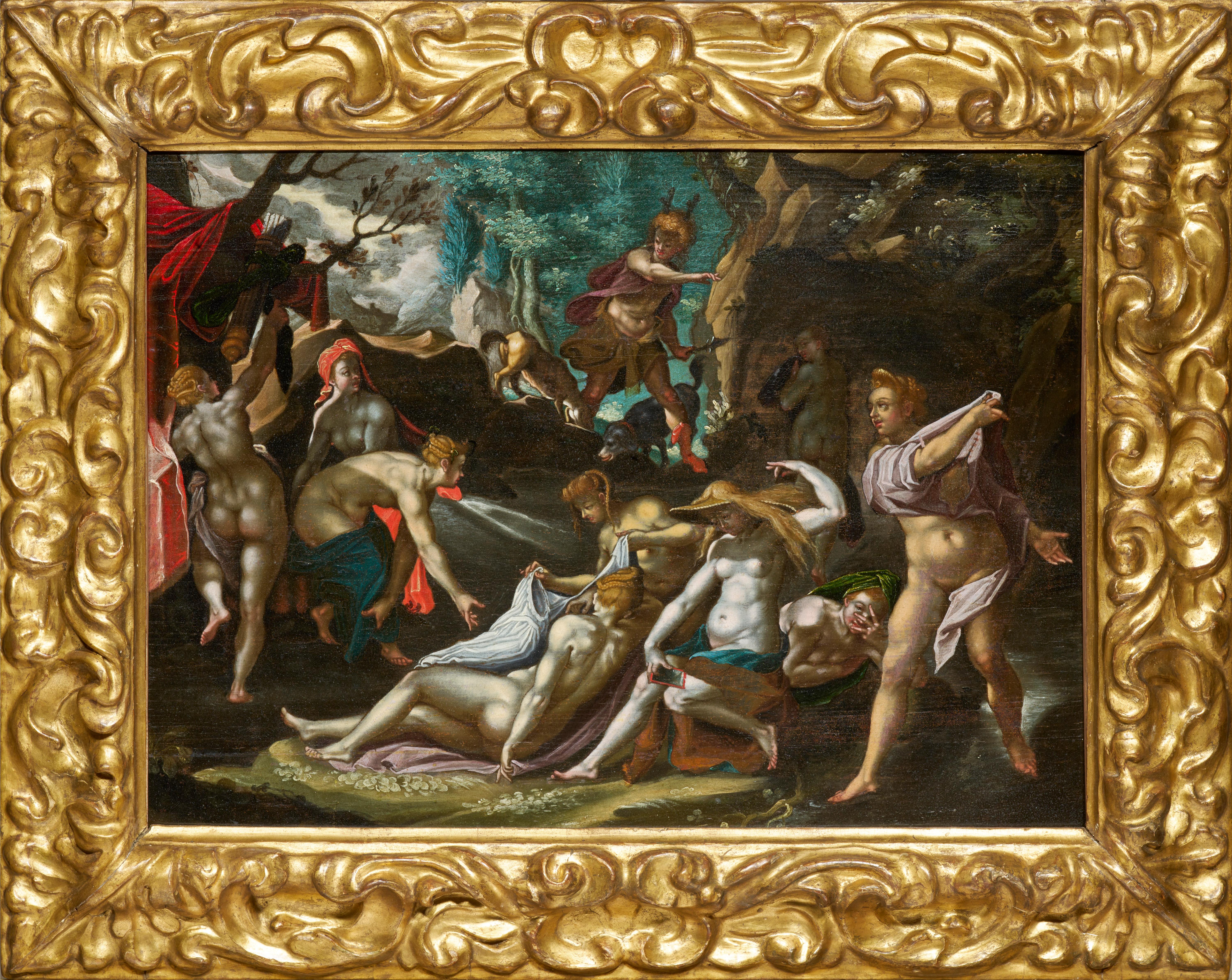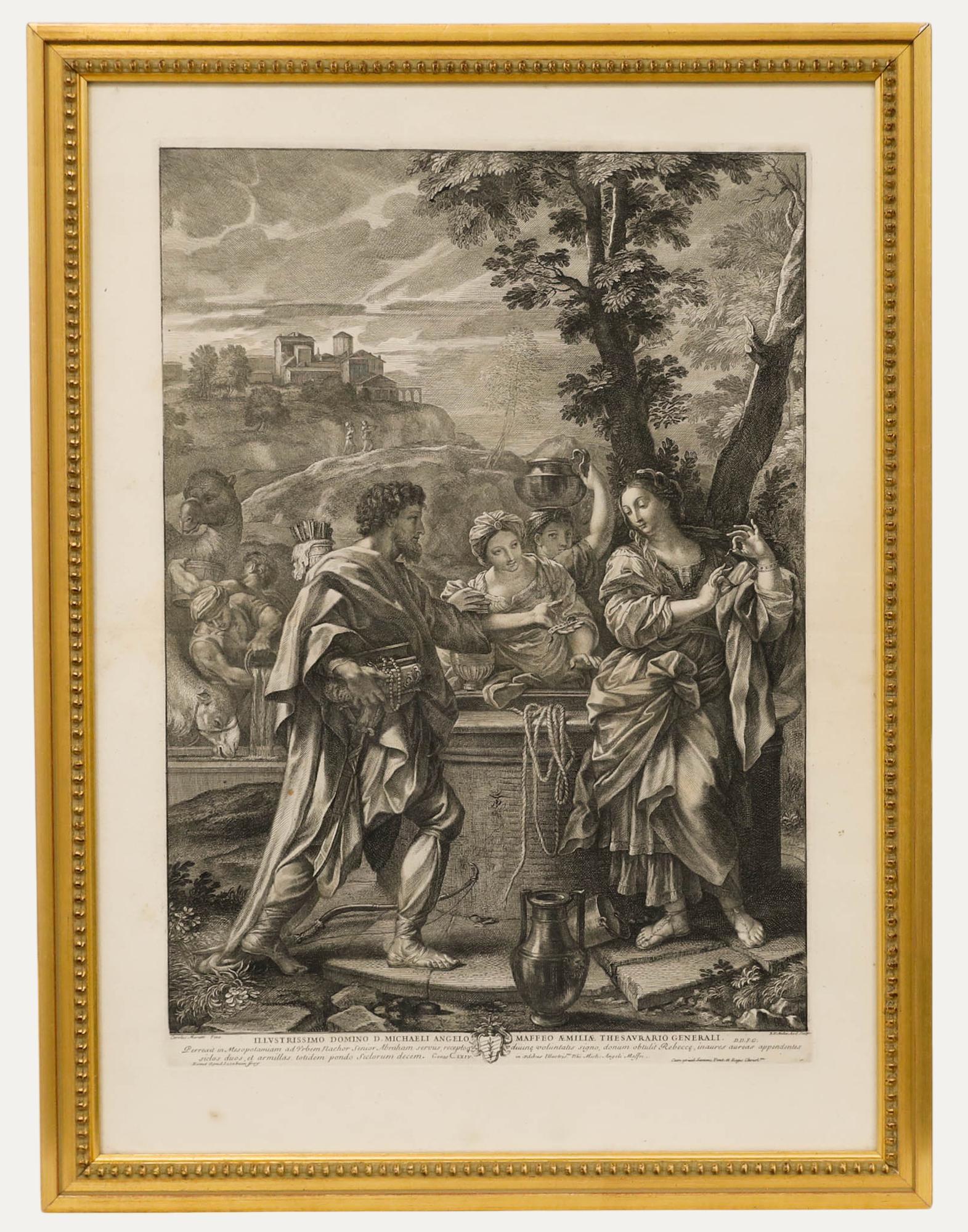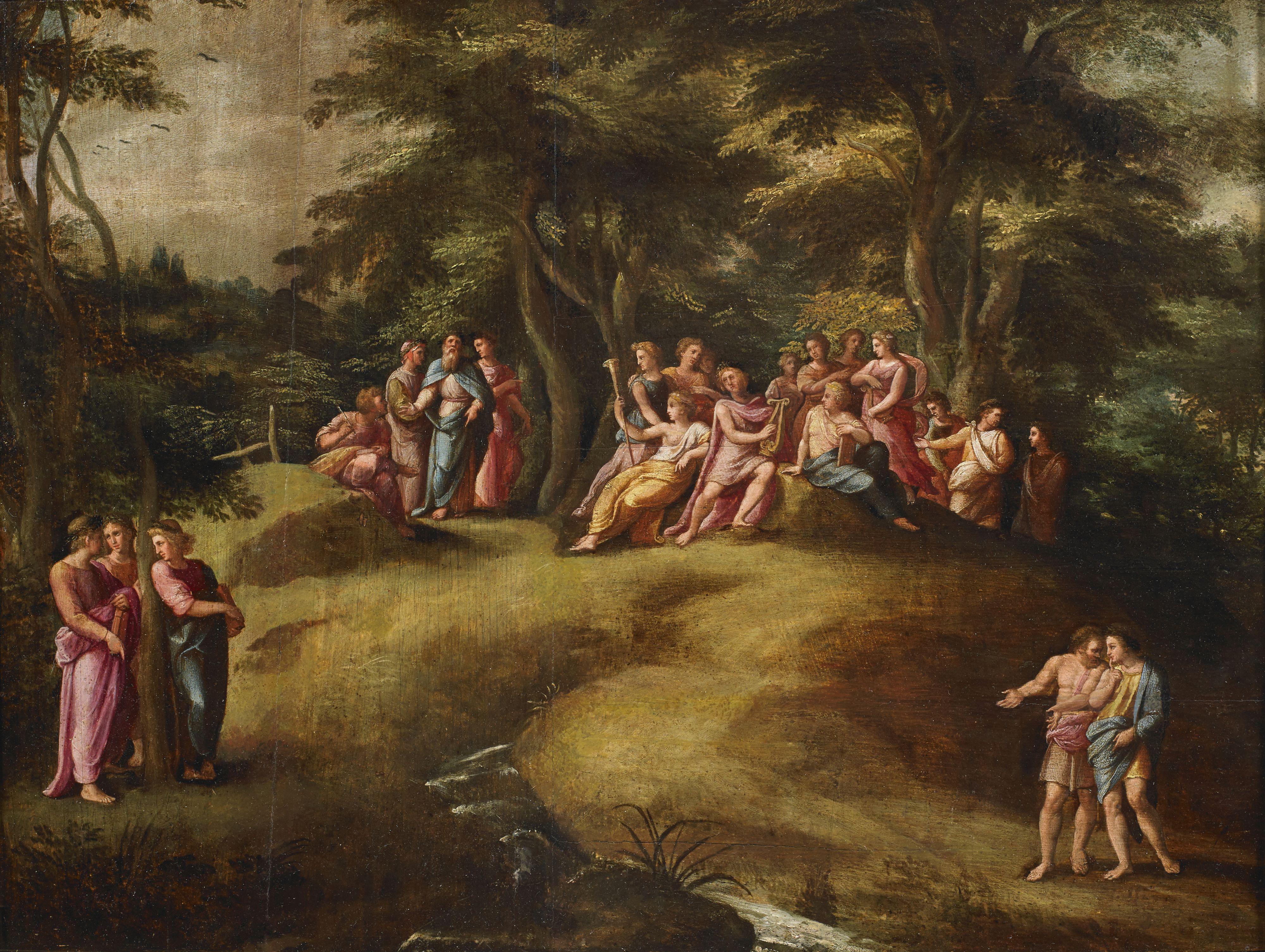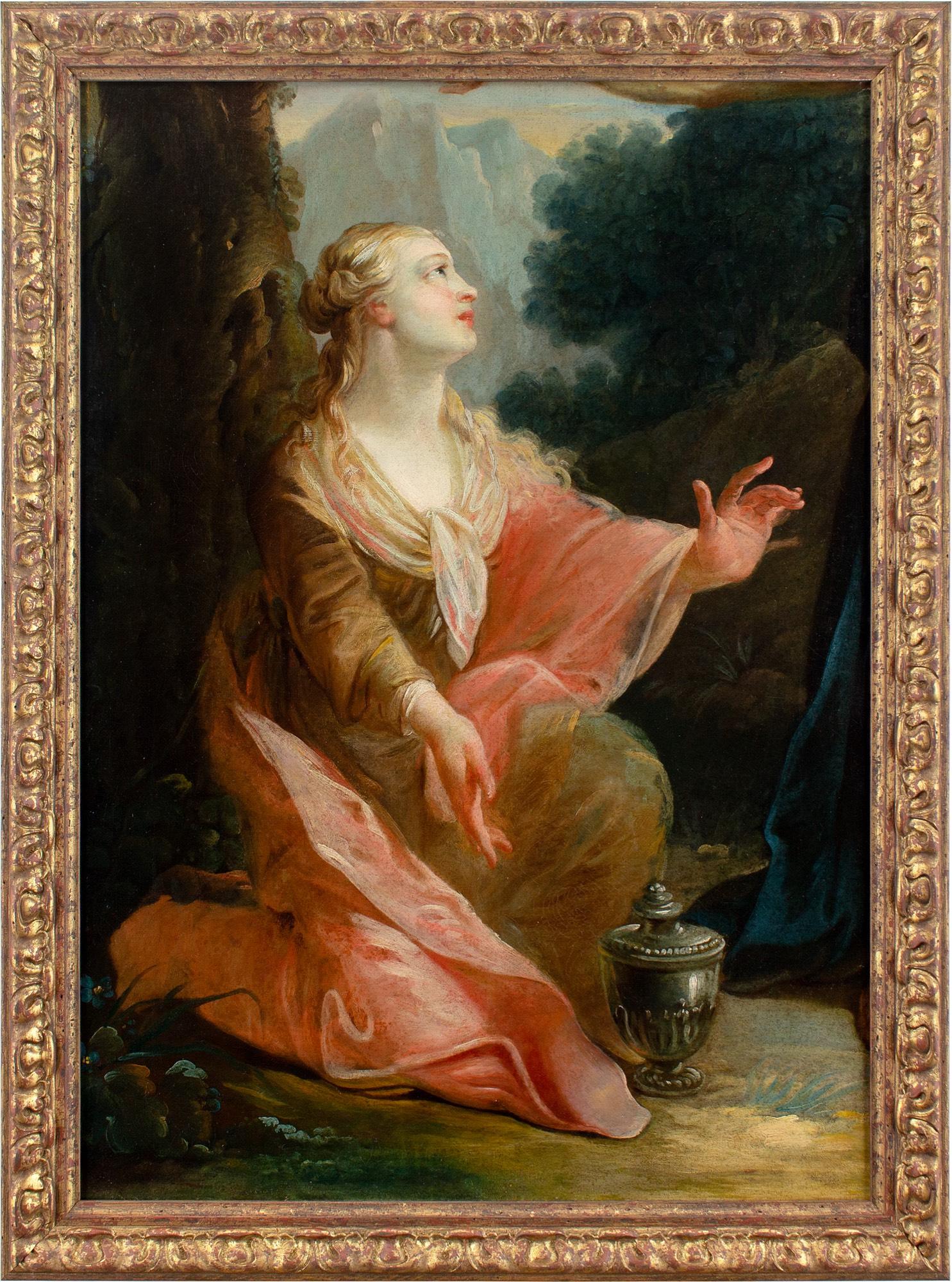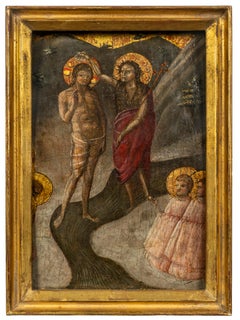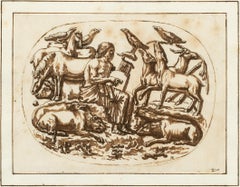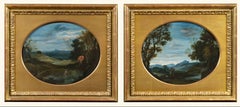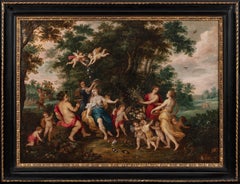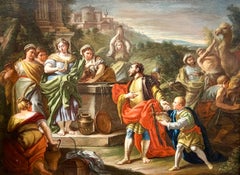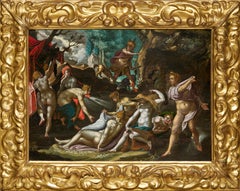Articoli simili a Rebecca at the Well
Vuoi altre immagini o video?
Richiedi altre immagini o video al venditore
1 di 4
Master of the Apollo and Daphne LegendRebecca at the Wellca. 1500
ca. 1500
39.245,14 €
Informazioni sull’articolo
Provenance:
Dr. James Henry Lancashire, Manchester-by-the-Sea, Massachusetts, by 1925; probably by descent to:
Private Collection, Cumberland Foreside, Maine, until 2018
This unpublished panel is a characteristic work of the Master of the Apollo and Daphne Legend, an anonymous Florentine painter in the circle of Bartolommeo di Giovanni, Domenico Ghirlandaio, and Sandro Botticelli. The artistic personality of the Master of the Apollo and Daphne Legend was independently recognized by Everett Fahy and Federico Zeri at roughly the same moment in time. Fahy originally dubbed this artist the Master of the Ryerson Panels but later adopted Zeri’s name for the artist, which derives from his eponymous works from the Samuel H. Kress collection (Figs. 1-2). Fahy posited that the artist was most likely a pupil of Ghirlandaio active from roughly 1480 to 1510, and that he may be identifiable with one of Ghirlandaio’s documented pupils to whom no works have been securely attributed, such as Niccolò Cieco, Jacopo dell’Indaco, or Baldino Baldinetti. The present painting was first attributed to this master by Everett Fahy in 1989, who became aware of its existence only after publishing his definitive studies on the artist.
The surviving body of work by the Master of the Apollo and Daphne Legend is largely composed of series of panels treating the same theme. In addition to the works illustrating the legend of Apollo and Daphne, there are also series on the themes of Susanna and the Elders and the story of Saint Joseph, among others. The subject of the present panel is drawn from Genesis 24, the story of Isaac. It is possible that our painting relates to another work by the artist depicting the Sacrifice of Isaac formerly in the collection of E. A. McGuire in Dublin, Ireland (Fig. 3), and that these two panels were originally part of a decorative scheme based on the story of Isaac.
Although the Master’s paintings of this type have traditionally been considered painted fronts of wedding chests, known as cassoni, the scale of these paintings and the fact that they are often part of a series indicates that they are more likely spalliera panels—paintings set into furniture or the wainscoting of a room. The biblical episode depicted in this painting centers on the theme of marriage, which suggests that this work was likely commissioned for the domestic interior of a newly married couple. The Master has transcribed into paint even the minute details of this Old Testament story, in which Abraham sends a servant to travel by camel to the land of his father and seek out a wife for his son Isaac. The servant is here shown at the well where he encounters Rebecca. As in the biblical account, Rebecca is shown offering water to the servant and his animals—which she delicately pours into a basin—and he in turn offers her jewelry.
A recent cleaning of the painting has revealed the camel paddle leaning against a rock in the lower left, which had been obscured by old overpaint, as well as several pentimenti in the camel’s feet, Rebecca’s pitcher, her proper left shoulder, and the hill in the upper right. Also now visible is the artist’s underdrawing for a structure in the right background, which ultimately was excluded from the final composition.
This painting was in the collection of Dr. James Henry Lancashire in Massachusetts in the early twentieth century. The only known documentation of the work is an image made of it during a photographic campaign undertaken by the Frick Art Reference Library in 1925. Although it was then classified as Umbrian School, Everett Fahy encountered the photograph in the Frick photographic archive in 1977 (shortly after the publication of his dissertation on the followers of Ghirlandaio) and recognized this work as by the Master of the Apollo and Daphne Legend.
The painting does not appear in either of the sales of the Lancashire collection. It may have descended in the family before reappearing in 2018. Although nothing is known about the provenance of the painting prior to it being in the Lancashire collection in 1925, it is possible that the painting was acquired from the Florentine dealer and tapestry restorer Giuseppe Salvadori. The only other known early Italian paintings from the Lancashire collection were purchased from Salvadori between 1924 and 1925. It is therefore likely that the present panel was purchased from Salvadori as well.
- Creatore:Master of the Apollo and Daphne Legend
- Anno di creazione:ca. 1500
- Dimensioni:Altezza: 63,19 cm (24,875 in)Larghezza: 114,94 cm (45,25 in)
- Tecnica:
- Movimento e stile:
- Periodo:
- Condizioni:
- Località della galleria:New York, NY
- Numero di riferimento:1stDibs: LU1027005632
Informazioni sul venditore
5,0
Venditore riconosciuto
Questi venditori prestigiosi sono leader del settore e rappresentano il massimo in termini di qualità e design.
Fondazione nel 1997
Venditore 1stDibs dal 2012
22 vendite su 1stDibs
Tempo di risposta standard: 13 ore
- SpedizioneRecupero del preventivo…Spedizione da: New York, NY
- Politica di reso
Alcune parti di questa pagina sono state tradotte automaticamente. 1stDibs non può garantire che le traduzioni siano corrette. L’inglese è la lingua predefinita del sito.
Garanzia di autenticità
Nell’improbabile caso in cui si verifichi un problema con l’autenticità di un articolo, contattaci entro un anno per ottenere un rimborso completo. DettagliGaranzia di rimborso
Se il tuo articolo non corrisponde alla descrizione, è danneggiato durante il trasporto o non arriva, contattaci entro 7 giorni per un rimborso completo. DettagliAnnullamento entro 24 ore
Hai un periodo di tolleranza di 24 ore per annullare il tuo acquisto, senza necessità di fornire spiegazioni.Venditori professionali selezionati
I nostri venditori di livello internazionale devono aderire a rigorosi standard di servizio e qualità, garantendo l’integrità delle inserzioni.Garanzia miglior prezzo
Se scopri che un venditore ha pubblicato altrove lo stesso articolo a un prezzo più basso, applicheremo lo stesso prezzo.Consegna globale affidabile
La nostra rete di vettori leader del settore offre opzioni di spedizione specializzate in tutto il mondo, inclusa la consegna personalizzata.Altro da questo venditore
Mostra tuttoBattesimo di Cristo
Provenienza:
Achillito Chiesa, Milano
Luigi Albrighi, Firenze, entro il 1° luglio 1955
con Marcello e Carlo Sestieri, Roma, 1969
Collezione privata, Connecticut
Esposto:
Mount Holy...
Categoria
Fino al XV secolo, Antichi maestri, Dipinti figurativi
Materiali
Tempera, Pannello in legno
Orfeo e gli animali, uno studio su un antico bassorilievo
Inscritto "55" e "218" in basso a destra.
Filigrana: Heawood 1351
Posato sullo storico monte Cassiano Del Pozzo
(Montaggio di tipo A, 531 x 402 mm)
Provenienza:
Commissionato da ...
Categoria
XVI secolo, Barocco, Disegni e acquarelli figurativi
Materiali
Carta, Inchiostro, Penna
Due scene di Diana e Atteone (una coppia)
Di Giovanni Battista Viola
Provenienza:
Robert L. e Bertina Suida Manning, New York, fino al 1996
Collezione privata, USA
Giovanni Battista Viola nacque a Bologna e lì studiò con Annibale Carracci, che seg...
Categoria
XVII secolo, Barocco, Dipinti (paesaggio)
Materiali
Rame
Allegoria dell'abbondanza
Dipinto in collaborazione con Hendrick van Balen (Anversa, 1575 - 1632).
Provenienza: Collezione privata, Uruguay, dagli anni '30.
Figlio maggiore di Jan Breughel il Vecchio, Jan i...
Categoria
XVII secolo, Antichi maestri, Dipinti
Materiali
Rame
Un capriccio architettonico con la predicazione di un apostolo
Di Giovanni Paolo Panini
Provenienza: Santambrogio Antichità, Milano; venduto nel 2007 a:
Filippo Pernisa, Milano; da chi è stato venduto, 2010, a:
Collezione privata, Melide, Svizzera
De Primi Fine A...
Categoria
XVIII secolo, Antichi maestri, Dipinti figurativi
Materiali
Tela, Olio
Ester nella Casa delle Donne di Assuero
Di Artus Wolfort
Nato ad Anversa, Artus Wolffordt si formò a Dordrecht dove divenne maestro nel 1603 all'età di ventidue anni. Tornò nella sua città natale nel 1615 e inizialmente lavorò come assist...
Categoria
XVII secolo, Antichi maestri, Dipinti
Materiali
Olio, Pannello
Ti potrebbe interessare anche
Rebecca al pozzo
Nicola Maria Rossi cattura magistralmente il racconto biblico di Rebecca ed Eliezer al pozzo, una storia tratta dal Libro della Genesi. In questa scena, il servo di Abramo, Eliezer, ...
Categoria
XVIII secolo, Antichi maestri, Dipinti figurativi
Materiali
Tela, Olio
Diana e Atteone, un dipinto manierista di Joseph Heintz il Vecchio
Questo dipinto ci ha sedotto con i suoi colori ricchi. Raffigurante Diana e le sue compagne sorprese da Atteone, si ispira a un'incisione di Aegidius Sadeler II dopo un dipinto di Jo...
Categoria
XVII secolo, Antichi maestri, Dipinti (nudo)
Materiali
Olio, Pannello in legno
Robert van Audenaerde dopo Carlo Maratti - Incisione, Rebecca al pozzo
Un'incantevole incisione del XVIII secolo che raffigura la scena religiosa di Rebecca al pozzo. Inscritto nella lastra. Presentato in una cornice dorata. Sulla carta.
Categoria
Inizio XVIII secolo, Stampe figurative
Materiali
Incisione
Saint Johns Dipinto Pasinelli 17° secolo Olio su tela Vecchio maestro
Lorenzo Pasinelli (Bologna, 1629 - 1700)
Sermone di Saint Johns Circa 1650.
Olio su tela 115 x 154 cm Con cornice 136 x 174 cm
Provenienza Milano, Porro 6 giugno 2006 olio s...
Categoria
XVII secolo, Antichi maestri, Dipinti
Materiali
Olio
20.696 € Prezzo promozionale
20% in meno
Parnaso del XVI secolo Biagio Pupini detto Biagio delle Muse Lame Olio su pannello
Questo dipinto (in ottimo stato di conservazione e di pregevole fattura esecutiva, testimonia l'enorme
fortuna delle invenzioni di Raffaello negli anni successivi alla sua morte: inf...
Categoria
XVI secolo, Scuola italiana, Dipinti figurativi
Materiali
Olio, Pannello
Venetian School del XVIII secolo, Maria Maddalena, Noli Me Tangere
Questo frammento di pittura a olio italiano della fine del XVIII secolo raffigura Maria Maddalena inginocchiata accanto a un vaso di alabastro. La mano di Cristo è parzialmente visib...
Categoria
XVIII secolo, Scuola italiana, Dipinti figurativi
Materiali
Olio, Tela
